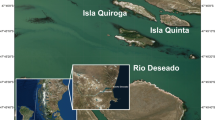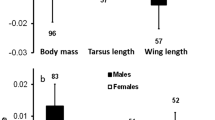Abstract
Females in most bird species engage in extra-pair copulations. Although this behaviour is widespread, benefits for females of doing so are less understood. The most widely accepted hypothesis is that they improve their previous choice of social partner and gain genetic benefits for their offspring. Some evidence for this comes from studies that find that extra-pair young (EPY) have greater fitness than their half-sibs. However, this might be also caused by maternal, non-genetic effect, a possibility that remains largely untested. Here we test whether EPY are laid in larger eggs or eggs laid early in the laying sequence in the collared flycatcher (Ficedula albicollis). The size of eggs bearing EPY and within-pair young (WPY) did not differ, however, EPY were laid in early eggs and consequently hatched earlier than WPY. As hatching asynchrony is a strong determinant of offspring size and survival in many species, including collared flycatcher, our results suggest that a caution is needed when paternal genetic effects are to be inferred from comparison of naturally occurring half-sibs.


Similar content being viewed by others
References
Balzer AL, Williams TD (1998) Do female zebra finches vary primary reproductive effort in relation to mate attractiveness? Behaviour 135:297–309
Barber I, Arnott SA (2000) Split-clutch IVF: a technique to examine indirect fitness consequences of mate preferences in sticklebacks. Behaviour 137:1129–1140
Birkhead T, Schwabl H, Burke T (2000) Testosterone and maternal effects: integrating mechanisms and function. Trends Ecol Evol 15:86–87
Burley N (1986) Sexual selection for aesthetic traits in species with biparental care. Am Nat 127:415–445
Charmantier A, Blondel J, Perret P, Lambrechts MM (2004) Do extra-pair paternities provide genetic benefits for female blue tits Parus caeruleus? J Avian Biol 35:524–532
Colegrave N (2001) Differential allocation and good genes: comment from Colegrave. Trends Ecol Evol 16:22–23
Cordero PJ, Wetton JH, Parkin DT (1999) Within-clutch patterns of egg viability and paternity in the House Sparrow. J Avian Biol 30:103–107
Cunningham EJA, Russell AF (2000) Egg investment is influenced by male attractiveness in the mallard. Nature 404:74–77
Cunningham EJA, Russell AF (2001) Differential allocation and ‘good genes’: comment from Cunningham and Russell. Trends Ecol Evol 16:21
Evans JP, Kelley JL, Bisazza A, Finazzo E, Pilastro A (2004) Sire attractiveness influences offspring performance in guppies. Proc R Soc Lond B 271:2035–2042
Gil D, Graves J, Hazon N, Wells A (1999) Male attractiveness and differential testosterone investment in zebra finch eggs. Science 286:126–128
Gil D, Graves J (2001) Differential allocation and good genes: comment from Gil and Graves. Trends Ecol Evol 16:21–22
Griffith SC, Owens IPF, Thuman KA (2002) Extra pair paternity in birds: a review of interspecific variation and adaptive function. Mol Ecol 11:2195–2212
Hillström L (1999) Variation in egg mass in the Pied Flycatcher, Ficedula hypoleuca: an experimental test of the brood survival and brood reduction hypotheses. Evol Ecol Res 1:753–768
Hoyt DF (1979) Practical methods of estimating volume and fresh weight of birds' eggs. Auk 96:73–77
Jennions MD, Petrie M (2000) Why do females mate multiply? A review of the genetic benefits. Biol Rev 75:21–64
Johnsen A, Andersen V, Sunding C, Lifjeld JT (2000) Female bluethroats enhance offspring immunocompetence through extra-pair copulations. Nature 406:296–299
Johnsen A, Delhey K, Andersson S, Kempenaers B (2003) Plumage colour in nestling blue tits: sexual dichromatism, condition dependence and genetic effects. Proc R Soc Lond B 270:1263–1270
Kempenaers B, Sheldon BC (1996) Why do male birds not discriminate between their own and extra-pair offspring? Anim Behav 51:1165–1173
Kempenaers B, Verheyen GR, Dhondt AA (1997) Extrapair paternity in the blue tit (Parus caeruleus): female choice, male characteristics, and offspring quality. Behav Ecol 8:481–492
Kleven O, Lifjeld JT (2004) Extrapair paternity and offspring immunocompetence in the reed bunting, Emberiza schoeniclus. Anim Behav 68:283–289
Kolm N (2001) Females produce larger eggs for large males in a paternal mouthbrooding fish. Proc R Soc Lond B 268:2229–2234
Krist M, Remeš V, Uvírová L, Nádvorník P, Bureš S (2004) Egg size and offspring performance in the collared flycatcher (Ficedula albicollis): a within clutch approach. Oecologia 140:52–60
Krokene C, Rigstad K, Dale M, Lifjeld JT (1998) The function of extrapair paternity in blue tits and great tits: good genes or fertility insurance? Behav Ecol 9:649–656
Lubjuhn T, Strohbach S, Brun J, Gerken T, Epplen JT (1999) Extra-pair paternity in great tits (Parus major): a long term study. Behaviour 136:1157–1172
Magrath RD (1990) Hatching asynchrony in altricial birds. Biol Rev 65:587–622
Michl G, Török J, Griffith SC, Sheldon BC (2002) Experimental analysis of sperm competition mechanisms in a wild bird population. Proc Natl Acad Sci USA 99:5466–5470
Møller AP (1992) Frequency of female copulations with multiple males and sexual selection. Am Nat 139:1089–1101
Møller AP, Ninni P (1998) Sperm competition and sexual selection: a meta-analysis of paternity studies of birds. Behav Ecol Sociobiol 43:345–358
Neff BD (2004) Increased performance of offspring sired by parasitic males in bluegill sunfish. Behav Ecol 15:327–331
Norris K (1993) Heritable variation in a plumage indicator of viability in male great tits Parus major. Nature 362:537–539
Piálek J, Albrecht T (2005) Choosing mates: complementary versus compatible genes. Trends Ecol Evol 20:63
Potti J (1998) Variation in the onset of incubation in the pied flycatcher (Ficedula hypoleuca): fitness consequences and constraints. J Zool 245:335–344
Qvarnström A, Pärt T, Sheldon BC (2000) Adaptive plasticity in mate preference linked to differences in reproductive effort. Nature 405:344–347
Rutstein AN, Gilbert L, Slater PJB, Graves JA (2004) Mate attractiveness and primary resource allocation in the zebra finch. Anim Behav 68:1087–1094
Saino N, Bertacche V, Ferrari RP, Martinelli R, Møller AP, Stradi R (2002a) Carotenoid concentration in barn swallow eggs is influenced by laying order, maternal infection and paternal ornamentation. Proc R Soc Lond B 269:1729–1733
Saino N, Ferrari RP, Martinelli R, Romano M, Rubolini D, Møller AP (2002b) Early maternal effects mediated by immunity depend on sexual ornamentation of the male partner. Proc R Soc Lond B 269:1005–1009
SAS Institute (2004) SAS/STAT 9.1 User's guide. SAS Institute Inc., Cary
Schmoll T, Dietrich V, Winkel W, Epplen JT, Lubjuhn T (2003) Long-term fitness consequences of female extra-pair matings in a socially monogamous passerine. Proc R Soc Lond B 270:259–264
Sheldon BC, Ellegren H (1996) Offspring sex and paternity in the collared flycatcher. Proc R Soc Lond B 263:1017–1021
Sheldon BC, Merilä J, Qvarnström A, Gustafsson L, Ellegren H (1997) Paternal genetic contribution to offspring condition predicted by size of male secondary sexual character. Proc R Soc Lond B 264:297–302
Sheldon BC, Ellegren H (1999) Sexual selection resulting from extrapair paternity in collared flycatchers. Anim Behav 57:285–298
Sheldon BC (2000) Differential allocation: tests, mechanisms and implications. Trends Ecol Evol 15:397–402
Sheldon BC (2001) Differential allocation and good genes: response from Sheldon. Trends Ecol Evol 16:23
Sheldon BC, Arponen H, Laurila A, Crochet PA, Merilä J (2003) Sire coloration influences offspring survival under predation risk in the moorfrog. J Evol Biol 16:1288–1295
Stoleson SH, Beissinger SR (1995) Hatching asynchrony and the onset of incubation in birds, revisited. In: Power DM (ed) Current ornithology 12. Plenum Press, New York, pp 191–270
Strohbach S, Curio E, Bathen A, Epplen JT, Lubjuhn T (1998) Extrapair paternity in the great tit (Parus major): a test of the "good genes" hypothesis. Behav Ecol 9:388–396
Veen T, Borge T, Griffith SC, Saetre GP, Bureš S, Gustafsson L, Sheldon BC (2001) Hybridization and adaptive mate choice in flycatchers. Nature 411:45–50
Veiga JP(1992) Hatching asynchrony in the house sparrow: a test of the egg-viability hypothesis. Am Nat 139:669–675
Westneat DF, Clark AB, Rambo KC (1995) Within-brood patterns of paternity and paternal behavior in red-winged blackbirds. Behav Ecol Sociobiol 37:349–356
Whittingham L, Dunn PO (2001) Survival of extrapair and within-pair young in tree swallows. Behav Ecol 12:496–500
Acknowledgements
We thank T. Grim, V. Pavel, V. Remeš, B. C. Sheldon, E. Tkadlec, K. Weidinger and several anonymous referees for valuable comments or discussion on several drafts of the manuscript. J. Stříteský greatly helped in the field. K. Weidinger kindly provided us plastic eggs. We owe forest enterprise Čechy pod Kosířem for providing the nest-boxes and the caravan. M. K. thanks Kačenka for encouragement and support. This study was supported by grants from the Czech Ministry of Education (MSM 6198959212) and from GAČR (No. 206/03/0215). The study was approved and supervised by the Ethical Committee of Palacký University and complies with the current law of the Czech Republic.
Author information
Authors and Affiliations
Corresponding author
Additional information
Communicated by J. Graves
Rights and permissions
About this article
Cite this article
Krist, M., Nádvorník, P., Uvírová, L. et al. Paternity covaries with laying and hatching order in the collared flycatcher Ficedula albicollis . Behav Ecol Sociobiol 59, 6–11 (2005). https://doi.org/10.1007/s00265-005-0002-2
Received:
Revised:
Accepted:
Published:
Issue Date:
DOI: https://doi.org/10.1007/s00265-005-0002-2




